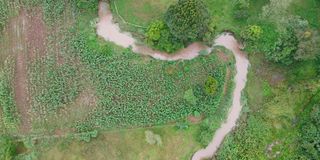River Yala basin roaring back to life after years of degradation

Some farmers in Chebarbar, Nandi County, have cultivated crops along the banks of River Kabutiei, a tributary of Yala River. But restoration of the ecosystem is now on course.
What you need to know:
- Wetlands have immense water storage benefits.
- They act like a natural buffer, or sponge, holding water that sinks into the ground and is filtered through a natural process.
It is said that water is life — it is essential for all living things. And one of the greatest lifelines in the country is River Yala and its catchment, which traverses Nandi, Kericho, Kakamega, Vihiga and Siaya counties. The 219-kilometre long river supports 1.7 million people, mainly for agriculture and fishing.
Along its course, River Yala is surrounded by wetlands — areas of land permanently covered by water or temporarily saturated with water. Wetlands have immense water storage benefits. They act like a natural buffer, or sponge, holding water that sinks into the ground and is filtered through a natural process. Wetlands, therefore, play a significant role in reducing the severity of downstream flooding and erosion.
They're also considered among the most biologically diverse ecosystems. But according to the UN Millennium Ecosystem Assessment, they are more affected by environmental degradation than any other ecosystem on Earth.
In Nandi County, King'wal wetland spans 3,200 hectares. It is one of the two critical wetlands within the River Yala catchment and home to an endangered antelope in Western Kenya — the Sitatunga. These are rare, swamp-dwelling mid-size antelopes that rely an adequate supply of food year-round to survive. Wetlands rely on them to keep the vegetation from overgrowing. But the antelopes, which used to graze in herds back in the day, have now been reduced to just a few due to misuse of wetlands.

A crane at an area that used to be a wetland in Chebarbar, Nandi County on April 25.
Smallholder farmers, who occupy over 90 per cent of the land within this catchment area, use the wetlands for farming due to the shrinking fertile land and because wetlands are the most productive ecosystems during the dry season as they continuously supply areas with water.
But all is not doom and gloom.
Some parts of Yala catchment such as Kingwal have been rehabilitated. In Kapsisiyua, Lucy Jelagat, the secretary of Chepling'won Water Resources Users Association, explains that 20 years ago, the community would cultivate acres of land. But over time, they noticed the negative effects of human activities such as deforestation and thus decided to stop practising agriculture.
But in some areas, acres of wetlands are being burnt. Some believe this is to flush out the sitatungas so they can be hunted for food, or to allow livestock to feed on fresh green shoots, which eventually grow on the wetlands.
Communities need alternative livelihood options for wetlands to be properly conserved. Lucy says she encourages this through her association.
"I sensitise people, mostly women, on how to plant trees, bamboo trees and avocados as well keep poultry so they can make money. I also encourage them to plant Napier grass around the buffer zone to control soil erosion."
The sales empower women, encouraging them to actively participate in catchment conservation.
Dr Stella Wanjala, the founder of the Umbrella organization Women in Water, is also making a difference. Her organisation has collaborated with The Nature Conservancy's River Yala Water Fund, which aims to restore the catchment areas in the Yala River basin.
"This is the first globally found women-led water fund. Women bear the brunt of environmental degradation as well as water and food crises. That's why we are putting more efforts to take care of the watershed — to come in with alternative sources of livelihood and give locals a reason to move out of the watershed so it can benefit them," she said.
The Yala Water Fund is incentivising farmers by providing water pans and liners to enable them to harvest water from house roofs and flooding. Edwin Serem's farm benefits from this water harvesting technology, which captures rainwater and controls surface runoff.
"I used to farm along the river bank because I had no alternative. There is no water up here on the shamba and thus our crops would dry. But now we no longer have challenges, thanks to the water pan," says the farmer.
The fund intends to construct 400 water pans by May 2025, which have the potential to harvest a minimum of 40 million litres of water per year.
The Nature Conservancy (TNC) is instrumental in supporting the restoration of Yala's catchment areas through the Fund. Stephen Kibet, the Resilient Watersheds Manager, explained why it is a worthwhile investment. "The main mission of TNC is to conserve nature and so it's essential to ensure sustainable livelihoods for the local community."
TNC has already invested Sh40 million into the Yala project by purchasing seedlings to plant in farmlands and protected areas, avocados, super Napier grass and bamboo to create a buffer zone in wetlands. They also provide technical support to lay the water pans and buy the liners, mainly for household use. The cost of a 100,000-litre water pan is around Sh30,000. So far, 248, 620 tree seedlings have been planted in the ecosystem in the last two months. "When you look at the way we have designed the model, we are building a fund and putting resources in so the community can be self-reliant, and thus they can conserve the environment when they have more money in their pockets,” he said.
By 2025, the project aims to restore 31,915 hectares of degraded indigenous forest, 525 km of the river's riparian buffer areas and 3,200 hectares of other riparian areas. But according to Stephen, public-private partnership is important in sustaining the project.
Extreme climates, forest destruction and the encroachment of wetlands disrupt a delicate natural balance, resulting in increased flooding, habitat loss and devastating consequences, as witnessed in some parts of the country in April. It is a harsh reminder for both communities and stakeholders that they must safeguard wetlands.
[email protected]. Catch the details of the ‘Yala Water Warriors’ tonight on ‘NTV Wildtalk’




